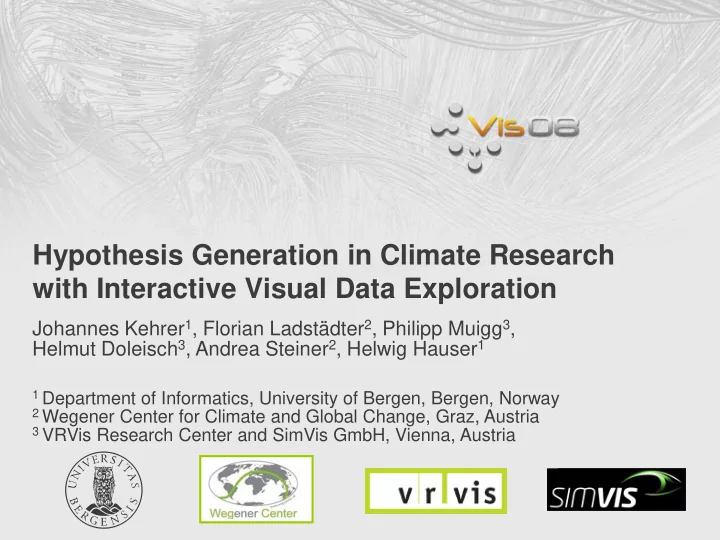

Hypothesis Generation in Climate Research with Interactive Visual Data Exploration Johannes Kehrer 1 , Florian Ladstädter 2 , Philipp Muigg 3 , Helmut Doleisch 3 , Andrea Steiner 2 , Helwig Hauser 1 1 Department of Informatics, University of Bergen, Bergen, Norway 2 Wegener Center for Climate and Global Change, Graz, Austria 3 VRVis Research Center and SimVis GmbH, Vienna, Austria
Climatological Background Investigation and detection of climate change Upper troposphere-lower stratosphere known to be sensitive investigate key climate parameters Hypothesis generation identify potential sensitive & robust indicator regions for climate change (e.g., certain height layers, latitudes) characteristic climate signals, which deviate from natural climate variability useful to monitor atmospheric change Kehrer et al. 2
Usual Workflow and Goal Set research focus Acquire data Explore / investigate data Formulate particular hypothesis large-cycle iterations Evaluate with statistics Iterate Challenging to come up with new hypotheses intuition of expert, scientific trial & error Goal: accelerate process (fast interactive visualization, more informed partner more directed search) Kehrer et al. 3
Climate Data and Challenges Data sources improved measurements & extensive simulations Challenges large, multi-variate data time-dependent deficiencies within data Difficult to analyze / understand usually statistical methods used require prior knowledge difficult to find “right” parameter settings Kehrer et al. 4
Data used in our Study Climate Simulation Data ECHAM5 climate model, A2 scenario [MPI-M Hamburg] (IPCC 4th assessment report) temperature, years 1961–2061 IPCC 20 th century run before 2001 180.000 simulation cells 2.5º x 2.5º, 18 pressure levels 108 time steps Kehrer et al. 5
Interactive Visual Data Exploration Enables visual dialogue between user and data SimVis: coordinated, multiple views framework (histograms, scatterplots, 3D/4D views, etc.) focus+context vis. degree-of-interest (DOI) d ata attribution ∈ [0, 1] hierarchical feature definition language on-the-fly data derivation interactivity, etc. Kehrer et al. 6
Recent Extensions of SimVis Function Graphs View [Muigg et al. 08] visualize large amounts of time-dependent data focus+context coloring color coding of features specified in different views transfer functions [Johansson et al. 05] map line count to pixel‘s luminance data aggregation (frequency binmaps) [Novotný & Hauser 06] Kehrer et al. 7
Advanced Brushing Techniques Select function graphs based on similarity pattern sketched by user similarity evaluated on gradients (1st derivative) Kehrer et al. 8
Our Exploration Process Interactive visual exploration for quick and flexible data investigation Integrated data derivation [Ladstädter et al. 08] linear trends moving differences computed on smoothed data signal to noise ratios (SNR) determine significance Generated hypotheses evaluated using statistics trend testing [Lackner et al. 08] Kehrer et al. 9
Start: Focus on Expressive Data Localize robust indicators strato- sphere area with high significance exclude low |SNR| tropo- smooth specification sphere south north exclude low SNR – + Kehrer et al. 10
Further Refinement Exclude upper pressure levels strato- sphere known deficiencies [Cordero & Forster ’06] tropo- sphere south north – + Kehrer et al. 11
Exploring Indicators Investigate less robust indicators emphasize feature coloring tropo- sphere south north – + Kehrer et al. 12
Explore Trend Variation over Time several highlighted neg. traces (2) high significance over whole investigated time span (robust) less robust indicators (3) features enhanced + – Kehrer et al. 13
Analyze Relations between Dimensions Up to now: investigation in one direction SNR check relation in other direction south north SNR similarity based brushing Kehrer et al. 14
Generated Hypothesis / ECHAM5 temp. Promising indicator region is strato- sphere seemingly located in lower stratosphere , geographically located at northern latitudes & tropo- tropics . sphere Corresponding cooling trend considered robust over whole investigated time span. south north hypothesis handed over to statistics strato- sphere + tropo- sphere – south north – + Kehrer et al. 15
Conclusions Visual Exploration of derived parameters (linear trends, SNR) rapidly generate promising hypothesis afterwards checked with classical statistics useful to narrow down parameter settings (statistics) in comparison to the original approach: faster , more flexible , and informed exploration Future work further integration of statistical methods in our visual exploration framework detailed quantitative evaluation of results w. statistics Kehrer et al. 16
Acknowledgements Wegener Center for Climate and Global Change, Austria Gottfried Kirchengast Bettina C. Lackner Austrian Science Fund Project INDICATE P128733-N10 Datasets are courtesy of Max-Planck-Institute for Meteorology, Hamburg European Centre for Medium-Weather Forecasts www.ii.UiB.no/vis Kehrer et al. 17
Recommend
More recommend